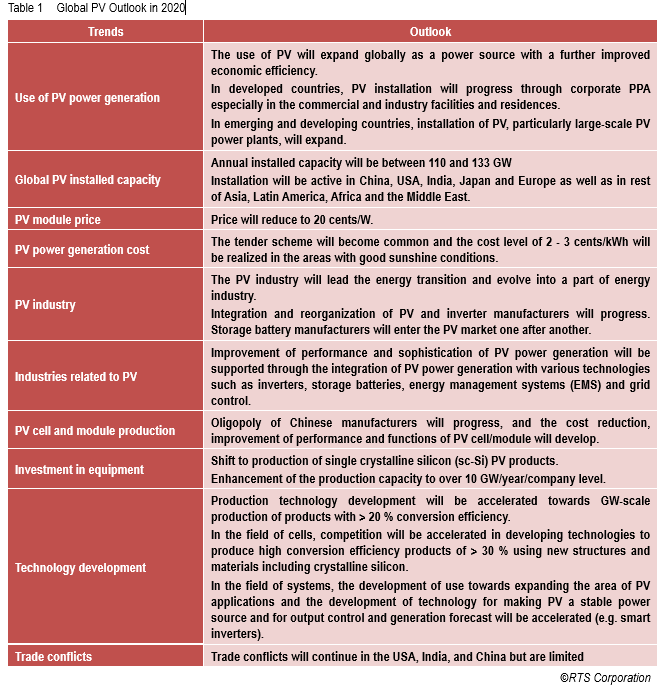The 2020s has started, which is expected to be a decade of turbulence and great change for PV power generation. The implementation of the Paris Agreement has begun in full scale and a bright decade will arrive with PV as the leading role in energy transition.
The main power source of over 200 GW power plants that are being newly built every year is shifting from conventional energy to renewable energy since 2015. PV and wind generation dominates most of the capacity of renewable energy, and the annual PV installed capacity has reached the 100 GW-level. In the 2020s, not only China and India but also other developing countries will begin full-scale PV installation, and the global market is expected to grow to the 200 to 300GW/year level.

In the PV market, there was a great recession of installation in China in 2019. However, in 2020, continuation of installation in the USA, recovery of installation in Europe, recovery of installation in China as a rebound, expansion of installation in developing countries are expected and the global PV market will once again get back on the growth trajectory. The global annual installed capacity in 2020 is expected to be between 110 and 133 GW with the developments of the countries listed above, as well as activation of installation in India, in the rest of Asia, Latin America, Africa and the Middle East.
In 2020, the economic rationality of PV will be further improved, and the trend of installation expansion will begin around the world regardless of developed or developing countries. The PV module price will approach 20 cents/W being supported by cost reduction of polysilicon as a starting material as well as improvement of PV cell/ module performances, along with expansion of demand. The PV power generation cost will be 2 – 3 cents/kWh in the areas with good sunshine conditions. Furthermore, while PV was installed mainly utilizing government support in the 2010s, from 2020 onwards, installation will shift to being based on market competition such as tender that does not rely on the FIT program, etc. and corporate PPA (renewable energy power purchase agreement by private companies). Under such circumstances, the PV industry will evolve itself from a manufacturing industry of mainly PV cells, modules and inverters into an energy supply industry that covers from manufacturing to generation business while aiming to integrate with cutting edge technologies such as energy storage, energy management, IoT, AI, drones, etc. and lead the energy transition of the 2020s.
In Japan, the draft on the revision of the current FIT Act is planned to be submitted to the present Diet session aiming to formulate the “new FIT Act” that is planned to be enforced in FY 2021 onwards. 2020 will be a year that determines the environment of the PV business in the 2020s. In the end of 2019, the direction of the “new FIT Act” was presented, based on the following pillars: 1) Establishment of scheme responding to the characteristics of power sources (competitive power source and locally-used power source), 2) Proper business discipline and 3) Next-generation electricity network that supports large-volume introduction of renewable energy. PV systems will be classified into competitive power source and locally-used power source depending on generation capacity. The requirements for locally-used power source will be set through the discussions at the ongoing meetings of the Procurement Price Calculation Committee, and some of the requirements are expected to be implemented in advance in FY 2020 (April 2020 to March 2021) which will be the last fiscal year under the current FIT Act.
As mentioned above, the year 2020 will be the preparation period for the “new FIT Act” which will take effect from FY 2021, and will be an important period to seek for the future business deployment. The subject for tender in FY 2020 will be expanded to include ≥ 250 kW systems, and the tender target capacity has been set at 1,500 MW. The purchase price is expected to decrease by about 2 Yen/kWh (1.84 cents/kWh) from FY 2019, estimating from the preconditions for pricing that has already been disclosed. Accordingly, the purchase price for FY 2020 will be the same level as the electricity charges so the advantages of selling PV electricity will be lost and the PV industry should shift to dissemination of PV systems that do not rely on the FIT program. In order to achieve this, the business strategy must be transitioned one year ahead of schedule, and the business deployment that focuses on installation of on-site self-consumption type PV systems installed mainly on rooftops of buildings and areas with power demand as well as off-site self-wheeling type PV systems is necessary.
The PV industry will aim to provide attractive PV systems and business models that have improved economic efficiency. At the same time, the industry and residences should work together with the government to actively set off a wave to enhance ambition of PV installation, and aim to establish a self-consumption type local society with high resilience through the PV market in which supply and demand are integrated (supply/ demand integrated market) that the government aims to establish. 2020 will be the starting year to achieve these objectives. In the 2020s, the PV industry will not only aim for independence, but also aim to show that self-supply of electricity by users can be achieved through installation of PV systems.
